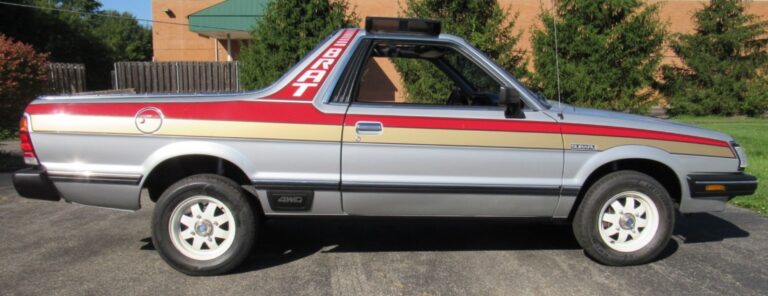The Isuzu Impulse Evolution: A Journey Through Design and Performance
The Isuzu Impulse, a nameplate that evokes a sense of sporty individuality and cutting-edge design, carved a unique niche in automotive history. From its inception, the Impulse aimed to be more than just another car; it was envisioned as a stylish statement, a driver’s car that blended Italian flair with Japanese engineering. This article delves into the fascinating evolution of the Isuzu Impulse, tracing its journey through different generations, models, and trim levels, highlighting the design philosophies and engineering advancements that defined this often-underappreciated gem.
The Genesis of Style: The First Generation (1977-1983)
The story of the Isuzu Impulse begins in 1977 with its debut in Japan. The car was a collaborative effort that underscored Isuzu’s ambition to produce a more visually striking and performance-oriented vehicle. The design, penned by the legendary Italian automotive designer Giorgetto Giugiaro, was undeniably its most captivating feature. Giugiaro, known for his work on iconic cars like the DeLorean DMC-12 and the Volkswagen Golf, infused the Impulse with sharp lines, angular creases, and a distinctive wedge-shaped profile.
Model and Trim Levels (First Generation):
The first-generation Impulse was primarily offered in Japan. While specific internal trim designations could vary, the key models were characterized by their engine configurations and feature sets.
- Impulse Standard/Giotto: This was the base model, typically featuring a 1.8-liter SOHC (Single Overhead Cam) engine. It provided the core Giugiaro styling with a focus on essential features.
- Impulse Sports/X/R: These sportier trims often came equipped with a more powerful 1.8-liter DOHC (Double Overhead Cam) engine, offering improved performance. They also usually included enhancements like alloy wheels, sportier interior appointments, and sometimes external cosmetic upgrades.
- Impulse Turbo: Introduced later in the generation, this model featured a turbocharged version of the 1.8-liter DOHC engine, significantly boosting power and performance. This was the halo model for the first generation, targeting enthusiasts.
Underneath its striking exterior, the first-generation Impulse utilized a rear-wheel-drive platform. The suspension setup, with independent front suspension and a live rear axle, was typical for its era, but Isuzu engineers tuned it to provide a responsive and engaging driving experience. The interior, while reflecting the angular exterior design, offered a driver-focused cockpit with clear instrumentation and supportive seats.
The first-generation Impulse, while not a global phenomenon, garnered a dedicated following in Japan for its unique styling and spirited performance. It established the Impulse nameplate as a symbol of individuality and a departure from the more conventional offerings in the market.
.
THIS could come in handy for your auto garage (and everywhere else!):

.
A Bold Evolution: The Second Generation (1983-1989)
In 1983, Isuzu unveiled the second-generation Impulse, a vehicle that retained the core spirit of its predecessor while embracing a more contemporary design and enhanced engineering. While Giorgetto Giugiaro’s direct involvement was less pronounced in this iteration, the design still carried a strong sense of proportion and a sporty demeanor. The angularity of the first generation softened into more aerodynamic curves, presenting a sleeker, more modern silhouette.
This generation also marked a significant expansion in its availability, with the Impulse being exported to various international markets, notably North America under the Piazza nameplate. This global reach allowed a wider audience to experience Isuzu’s unique take on the sporty coupe.
Model and Trim Levels (Second Generation):
The second-generation Impulse offered a more diverse range of models and trims, catering to different performance expectations and luxury preferences.
- Impulse (Base/JT/X): These were the entry-level models, typically powered by a 2.0-liter SOHC engine. They offered the core Impulse experience with a focus on comfort and style.
- Impulse RS (Record Sprint): This sportier trim often featured a DOHC version of the 2.0-liter engine and incorporated performance enhancements such as revised suspension tuning and often larger wheels.
- Impulse Turbo/Turbo-R: These models were the performance flagships, equipped with a turbocharged 2.0-liter DOHC engine. The “R” designation typically indicated even more aggressive tuning and sportier features, often including limited-slip differentials and sport seats.
In North America, the second generation was sold as the Isuzu Piazza. The trim levels mirrored the Japanese offerings with slight variations in naming conventions.
- Piazza (Base): This model featured the naturally aspirated 2.0-liter engine and was positioned as a stylish and affordable sporty coupe.
- Piazza Turbo: This was the performance-oriented version, equipped with the turbocharged 2.0-liter engine, offering a significant power upgrade.
The second-generation Impulse/Piazza also transitioned to a front-wheel-drive platform. This was a common trend in the automotive industry at the time, driven by packaging efficiency and improvements in traction. However, Isuzu engineers worked diligently to maintain the car’s sporty handling characteristics, employing sophisticated suspension designs to mitigate the typical compromises of front-wheel drive in a performance coupe.
The interior of the second generation became more refined, with a focus on ergonomics and a greater sense of upscale appointments. Higher trim levels offered features like leather seats, power amenities, and improved sound systems, bridging the gap between sportiness and everyday usability.
The second-generation Impulse/Piazza proved to be a more successful export than its predecessor, gaining recognition for its distinctive styling and engaging driving dynamics, especially in its turbocharged variants. It solidified Isuzu’s reputation for offering compelling alternatives in the coupe market.
The Apex of Design and Performance: The Third Generation (1989-1994)
The final iteration of the Isuzu Impulse arrived in 1989, representing the pinnacle of its design and engineering evolution. This generation, while retaining the “Impulse” name in most markets, continued the “Piazza” designation in some regions for a period. This generation was characterized by a more sculpted and flowing design, a departure from the sharper angles of its predecessors, and a stronger emphasis on refined performance.
Model and Trim Levels (Third Generation):
The third-generation Impulse offered a sophisticated range of models, focusing on both comfort and sporty performance.
- Impulse (Base/S/XS): These models featured a naturally aspirated 2.0-liter DOHC engine, offering a balance of performance and fuel efficiency for everyday driving.
- Impulse SI (Sport Injection) / GTE (Grand Touring Estate – though this designation was more common for other Isuzu models, the spirit of GT was present): These sportier trims often came with enhancements like revised suspension tuning, sportier wheel designs, and improved interior appointments.
- Impulse Turbo / Turbo RS: These were the high-performance variants, powered by a more potent turbocharged 2.0-liter DOHC engine. The Turbo RS, in particular, represented the ultimate expression of the Impulse’s performance capabilities, often featuring advanced drivetrains and aerodynamic enhancements.
In some markets, the early part of this generation might still have been referred to as the Piazza, but the “Impulse” name became more globally standardized.
This generation also saw further refinement of the front-wheel-drive platform. Isuzu engineers continued to optimize suspension geometry, and for some higher-performance models, the option of a sophisticated all-wheel-drive (AWD) system became available. This was a significant technological advancement, providing enhanced traction and stability without compromising the car’s sporty character.
The interior of the third-generation Impulse received a significant upgrade in terms of luxury and technology. Materials were generally of a higher quality, and the design was more cohesive and driver-centric. Features like climate control, premium audio systems, and optional leather upholstery became more common, positioning the Impulse as a more premium offering in the sporty coupe segment.
The third-generation Impulse was also notable for its advanced engine technology. Isuzu’s expertise in diesel engines, while not applied to the Impulse, influenced their approach to developing efficient and powerful gasoline engines, including the sophisticated turbocharged units that provided exhilarating performance.
However, the automotive landscape was changing rapidly. The rise of the SUV and a general shift in consumer preferences towards practicality began to impact the market for sporty coupes. Despite its strengths in design, performance, and engineering, the Isuzu Impulse faced stiff competition and the declining demand for its segment. Production of the Impulse eventually ceased in 1994, marking the end of a distinctive lineage.
Legacy of the Impulse
The Isuzu Impulse, across its three generations, stands as a testament to Isuzu’s willingness to experiment and push boundaries. It was a car that dared to be different, blending artistic design with capable engineering.
- Design Icon: Giorgetto Giugiaro’s influence on the first generation established the Impulse as a design statement, a car that turned heads for its sharp, futuristic lines. This aesthetic legacy continued to inform the subsequent generations, even as the design language evolved.
- Driver Engagement: Isuzu consistently prioritized a rewarding driving experience. Whether rear-wheel-drive or front-wheel-drive, the Impulse was tuned to offer responsive handling and spirited performance, especially in its turbocharged and performance-oriented trims.
- Technological Innovation: The adoption of DOHC engines, turbocharging, and later, the option of all-wheel-drive, showcased Isuzu’s commitment to incorporating modern automotive technology into their vehicles.
- Niche Appeal: The Impulse never aimed for mass-market dominance. Instead, it cultivated a loyal following among those who appreciated its individuality, its distinct styling, and its performance capabilities. It was a car for the discerning driver who sought something beyond the ordinary.
While production of the Isuzu Impulse concluded in 1994, its legacy endures. It remains a fondly remembered car by enthusiasts and collectors, celebrated for its unique character, its evolution through distinct generations, and its contribution to the diverse tapestry of automotive history. The Impulse was more than just a car; it was a statement of intent, a fusion of art and engineering that continues to inspire appreciation for bold automotive design and engaging driving dynamics.







